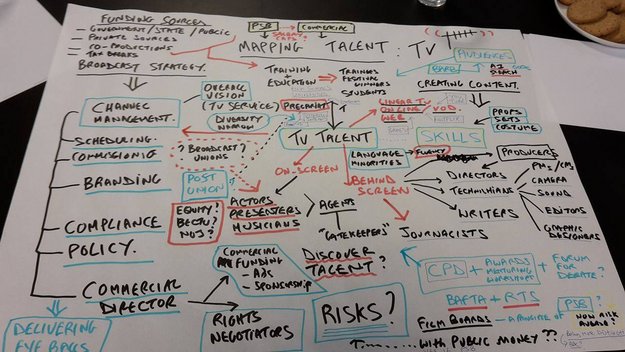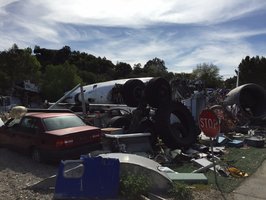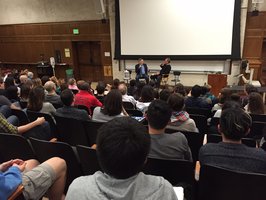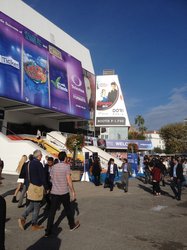Here you will find the most recent updates of the research project. In our blog, the researchers will share small reports from conferences they attend, give look into their latest work and tell about their project related activities. In the column on the right you can find other news related to the project.
Ushma was in Japan in June 2016 on a second round of fieldwork to map the travel of DR’s drama series to a country with a penchant for crime series. Continuing the connections and relationships established last year, she had further interactions with programme acquisition managers from four Japanese television channels: NHK, AXN Mystery, WOWOW and Super!Drama. The last two have shown Those who Kill, The Killing, The Bridge and Borgen (referred to as Copenhagen in Japan). Although the numbers of viewers of Danish TV drama series are relatively small in comparison with those in other countries, and the interest in them have not prompted any excessive media focus, they have been described as “meaningful for a few” by one acquisition manager. Interestingly enough, many of the comments made by acquisition professionals, journalists and regular viewers reinforced well-established arguments related to the success of such television dramas outside Denmark: the presence of strong female protagonists caught in heart-wrenching dilemmas between their personal and professional lives; the mellow and dark colours and hues, which have come to signal Nordic Noir; good-looking interiors (that can be bought) and gender equality and relaxed and informal attitudes (that cannot). A scriptwriter who had written a number of popular television dramas in Japanese mentioned how the skill of “writing emotion” had impressed her. These comments prompts us to ask: well, if television stations and viewers in different parts of the world speak of similar criteria that feed into the enjoyment and success of these series - then where do the differences lie? Another insight gained was how Danish TV drama series seem to reach Japan not directly, but via their popularity in the UK and US. As one acquisitions professional explained: “We watching, checking English, like BBC and Sky TV and we check English entertainment site and then we see Killing is very popular in BBC 4”. There seems to be a need to examine the mediating role that Anglophone countries may play in the broadcasting decisions taken in Japan. Ushma also met with the Japanese and Danish translators who worked on the subtitled and dubbed versions. Many concrete details on translation challenges emerged from these conversations. It became acutely evident that the complex nature of the translation processes comprised lengthy negotiations on prices and quality, unnerving time schedules, competition between translators, discrepancies between the English and Danish scripts, discrepancies between the Danish speech and English script, the demands of limits on subtitle length and frequent and irritating mail correspondence from rewriters who worked with synchronization between different languages. All controversial issues that impact the manner by which Danish TV drama series travel.
Ushma was in Japan in June 2016 on a second round of fieldwork to map the travel of DR’s drama series to a country with a penchant for crime series. Continuing the connections and relationships established last year, she had further interactions with programme acquisition managers from four Japanese television channels: NHK, AXN Mystery, WOWOW and Super!Drama. The last two have shown Those who Kill, The Killing, The Bridge and Borgen (referred to as Copenhagen in Japan). Although the numbers of viewers of Danish TV drama series are relatively small in comparison with those in other countries, and the interest in them have not prompted any excessive media focus, they have been described as “meaningful for a few” by one acquisition manager.
Interestingly enough, many of the comments made by acquisition professionals, journalists and regular viewers reinforced well-established arguments related to the success of such television dramas outside Denmark: the presence of strong female protagonists caught in heart-wrenching dilemmas between their personal and professional lives; the mellow and dark colours and hues, which have come to signal Nordic Noir; good-looking interiors (that can be bought) and gender equality and relaxed and informal attitudes (that cannot). A scriptwriter who had written a number of popular television dramas in Japanese mentioned how the skill of “writing emotion” had impressed her. These comments prompts us to ask: well, if television stations and viewers in different parts of the world speak of similar criteria that feed into the enjoyment and success of these series - then where do the differences lie?
Another insight gained was how Danish TV drama series seem to reach Japan not directly, but via their popularity in the UK and US. As one acquisitions professional explained: “We watching, checking English, like BBC and Sky TV and we check English entertainment site and then we see Killing is very popular in BBC 4”. There seems to be a need to examine the mediating role that Anglophone countries may play in the broadcasting decisions taken in Japan.
Ushma also met with the Japanese and Danish translators who worked on the subtitled and dubbed versions. Many concrete details on translation challenges emerged from these conversations. It became acutely evident that the complex nature of the translation processes comprised lengthy negotiations on prices and quality, unnerving time schedules, competition between translators, discrepancies between the English and Danish scripts, discrepancies between the Danish speech and English script, the demands of limits on subtitle length and frequent and irritating mail correspondence from rewriters who worked with synchronization between different languages. All controversial issues that impact the manner by which Danish TV drama series travel.
After participating in the Sustaining Talent in Small Nations [1] workshop in Aarhus I can still feel the high after all the wonderfully productive discussions. I find that some of the concepts that were discussed linger in my mind.
The first is talent as a conceptualisation of labour and value. That talent has value was underlined by Gunhild Agger’s (Aalborg University [2]) reminder regarding the etymological origins of the word talent which originally meant money. Talent is (and can be thought of as) a monetary unit. What a wonderfully concrete way of thinking of what talent actually means and requires in the context of working conditions! If you want to cultivate talent, you need funding. And yet so many of the young “talents” in the film and TV industry are often given very low wages or even no wages at all. An explanation was offered at the workshop: the market is saturated. The supply of labourers is usually greater than the industry demand. Even in markets dominated by public service broadcasters, competitive market conditions seem to be in effect when we talk about recruiting talent. And while I was listening to both researchers and industry representatives talk about conditions for talent, I couldn’t help but wonder: is it the competitive market or government support that makes the best work conditions for talent and creativity? Or is it a combination? Maybe the same can be said for secure long-term employment in regard to cultivating creativity and talent? I don’t have an answer.
The second concept that lingered was protectionism. Juliana Engberg (European Capital of Culture Aarhus 2017 [3]) brought it up. In my mind protectionism describes a situation where a nation has become closed off. To escape protectionism you need to do something new and be bold. The impressive cross-media project “New Nordic Noir” for Aarhus 2017 was presented by the project manager and established film director Jakob Høgel [4]. The project features a TV series, a video game, and a museum exhibition. Betting on the hyped Nordic noir wave could be a clever move especially in these times. But the thing about trends, Juliana Engberg reminded us, is that they can end quite quickly. So instead we might benefit from asking: What should the next Danish “TV speciality” be? We need to be able to make more than one thing and more than one genre. And hopefully the cross-media approach will mean a greater diversification of styles and genres. Nevertheless, I think the concept of protectionism is useful. Professor Mette Hjort (University of Copenhagen [5]) mentioned her study of the “twinning scheme” between Danish and foreign film makers which sounded like a good example of an effort to escape protectionism. If you’re a small nation looking to expand (your horizons), then go abroad.
The third concept derived from the exciting group exercise where we had to cooperate about “mapping talent”. Exercises are a great way of creating variation. Representatives from both academia and industry worked together in such a productive way to achieve a common goal: How can we improve our notion of talent? This was the case throughout the whole workshop. Here is the result from the group that I participated in:

First of all it’s safe to say that talent is a complex theme, as the map clearly demonstrates. The players and factors that influence the handling of talent are numerous. But one concept stood out to me: Risks. Padrahic O’Ciardah from the Irish public service broadcaster TG4 [6] mentioned the importance of risk-taking accompanied by funding. You have to fund risk-taking. This really resonated with my understanding of what influences the discovery of talent and the cultivation of talent – and ultimately improves conditions for creativity. Commissioners need to have the courage to take risks. And in order to do that the funding (and the politicians or councils that decide where funding goes) needs to be courageous as well.
The fourth and final concept that keeps resonating in my head is diversity. By the end of the first day I felt fairly confident that diversity was important when recruiting talent. Mette Hjort's talk about the benefits of teaming up with foreign film makers had affirmed this. The connection between diversity and creativity looks obvious. But then my theoretical illusions about diversity shattered when hearing the refreshingly honest reply from Ronni Madsen, vice president of M2Film [7] when he was asked about diversity in recruitment: “No. This is not something we prioritise.” But the numbers were still very clear and showed their successful expansion for a period of years. So here I was thinking about the definite importance of diversity only to be confronted with what looked like a clear-cut example of the opposite. The connection between diversity and creativity was maybe not as obvious as I had thought. This really surprised me. What a healthy wake-up call for me. Though I’m not sure he had the same experience.
Nation branding prevails as a contested research domain that challenges both practitioners and researchers to define, question and illustrate contemporary transformations in the reputation of a country and its people. Historically, governments have assumed control over nation branding in strategic partnerships with national companies and agencies. Acknowledging the significance of managerial approaches to branding - strategic planning, product development, image positioning and efficient marketing, these practices are increasingly being transformed by and entangled with market transformations and the global circulation of creative industrial resources. In particular, we are witnessing novel constellations of partnerships and collaborations resulting in creative products that not only act as symbolic ammunition in nation branding but also prompt unpredictable modes of interaction across borders.
The two-day international colloquium held in Aarhus on 22nd - 23rd September 2016 gathered researchers to give thought-provoking presentations on the practices, approaches and challenges of nation branding and the role of creative industries from many locations in the world: Denmark, Sweden, Brazil, Post-Soviet nations, Switzerland, Spain, Singapore, the Arctic region, Luxembourg, Australia, Wales and Qatar. Researchers also presented their insights in terms of the ‘hocus pocus’ involved in nation branding, the association of nation branding to cultural diplomacy, the strategic use of media and technologies, and the involvement of unintended actors, popcultural flows and mediatized placemaking.
The colloquium featured three sessions with practitioners from the creative industries that play a considerable role in current branding efforts in Denmark: Visit Denmark, DR sales and Aarhus 2017 as the European capital of culture. The colloquium was co-convened by our research project in cooperation with the Department of Culture and Global Studies, Aalborg University and the Department of Business Communication, Aarhus University.



Update from Los Angeles
As some of you might now I am currently spending time in Los Angeles to do interviews with key industry people, study the entertainment business and follow courses at UCLA.
The Film School at UCLA is an interesting place. It’s filled with students that are mostly aspiring producers, script writers, agents, directors, etc - and probably a few aspiring scholars, though truth be told I haven’t met any yet. These students are offered an impressive array of both practical and theoretical classes on how to make film and television. And because this is Hollywood, certain classes on film and television are also visited by people from all other academic backgrounds - people from the business school, sociology, etc. Everybody wants to work in entertainment one way or the other. Especially the classes with visiting guests from the entertainment industry are popular. In Tom Nunan’s Master Class a (semi-) famous guest visits every week to tell the story of their careers. So far we’ve been graced with the presence of people like Brian Grazer, Academy Award-winning producer, and Ted Sarandos, head of content acquisition for Netflix.
They even have people from the industry teaching some of the classes. Tom Nunan was executive producer on the movie Crash (2004), and the class on Entertainment Economics is run by Michael Puopolo, current producer at Fox. These people are not academic in their teachings in any traditional sense, but they do have a profound knowledge of the industry and always know why x company bought y company.
I’m not the only visitor here. UCLA is also guested by Japanese and Chinese TV professionals who are sent out by their desperate TV channels back home to find out how on earth they get young Japanese and Chinese people to watch TV instead of youtube. To my knowledge they have not found a clear solution to that problem yet.
Studies at UCLA aside I’m also doing interviews here. So far I’ve interviewed Mikkel Bondesen, producer at Fuse Entertainment, Glenn Lund, producer at Viking Brothers Entertainment, and Diana Son, scriptwriter on Love is a Four Letter Word, which is a remake of Danish original TV series Nikolaj & Julie. I’ve got more interviews lined up. Lastly I’m doing US audience studies. That has proven to be quite a challenge. So far I’ve found that young Americans in general just haven’t watched Danish TV series and that viewing among an older audience is fragmented, at best, and elite. I’m still finding out about the audiences, so we’ll see what I end up with in the end of March when I’m going back to Denmark.
I brought my wife and six months old son here and they’re doing great - enjoying the Californian sun. We can’t believe that our time here is soon coming to an end. Only one more month to go. That said we certainly also look forward to coming home to colleagues, friends and family! Take care until then.
All the best,
Lynge

1864 er den hidtil dyreste nordiske film- og tv-produktion. Det er også den mest omdiskuterede danske tv-serie til dato. Serien skulle afrunde 150-året for 2. Slesvigske Krig i 1864 med en storstilet dramasatsning på DR, men den endte som en sand skyttegravskrig mellem forsvarer og modstandere. Konsekvensen blev, at en tv-serie med gennemsnitligt 1,34 mio. seere blev betragtet som et flop i de danske medier. Men hvad skete der egentlig under denne debat? Hvad var det historikerne reagerede på? Hvordan blev tv-serien finansieret og produceret? Hvilke konsekvenser havde serien for DR som institution og som brand? Hvad blev det endelige resultat af satsningerne? Hvordan forholder serien sig til fortiden og vores samtid? Hvilken betydning havde 1864 som lokal medieproduktion på Fyn? Hvordan forholder seerne sig til serien og dens modtagelse? Hvordan ser modtagelsen ud uden for Danmark? Hvad er baggrunden for den politiske modtagelse af serien? Og hvordan ser filmen 1864 ud, og hvorfor ser vi ikke den i de danske biografer?
Bogen besvarer alle disse spørgsmål og mange flere med grundige og tankevækkende analyser. I modsætning til den kritiske modtagelse i efteråret 2014 vurderer denne bog, at det fra flere almindelige synsvinkler inden for medieforskningen er muligt at se på 1864 som en succes. Ud over de 14 kapitler om og forskellige synsvinkler på serien indeholder bogen også et fyldigt interview med instruktør Ole Bornedal samt et interview med historikeren Rasmus Glenthøj. Bogen er rigt illustreret med mange billeder fra tv-serien.
1864: tv-serien, historien, kritikken er den første udgivelse, der dækker tv-serien i sin helhed fra idé til debat, fra produktion til modtagelse, fra kritik til succes.
Bogen er redigeret af Kim Toft Hansen, medieforsker ved Aalborg Universitet. Han har siden seriens udsendelse forsket intensivt i tv-serien 1864 og deltager i forskningsprojektet What Makes Danish TV Drama Series Travel? bl.a. med et delprojekt om 1864.
I og op til jubilæumsåret for krigen i 1864 kom der en stribe udgivelser om det historiske. I disse udgivelser kan jeg se, at der er en række modsatrettede konklusioner på kilderne. Dem kunne jeg ikke se reflekteret i debatten om tv-serien 1864, hvor det virkede til, at en større gruppe historikere var enige om at slagte serien, selvom den i flere konklusioner lænede sig pænt op ad sit ophav, Buk-Swientys bøger om krigen.
Grunden til, at jeg skriver, at det er en bog om krigen om en dansk tv-serie, er på den ene side en henvisning til Ole Bornedal selv, der på et tidspunkt sagde, at han ikke havde forventet at starte en borgerkrig. Men samtidig er hele modtagelsen af serien et udtryk for en skyttegravskrig mellem især to positioner – de stærkt kritiske og dem, der talte for serien. Det blev også ofte udtrykt i behandlingen er serien gennem en gennemgående krigsmetaforik i journalistikken. Fx bragte BT og Ekstrabladet hver sin anmeldelse af første afsnit. BTs overskrift var ”Fuldtræffer”, mens Ekstrabladets var ”Løst krudt”.
Gennemgående så vi to lejre udkæmpe et ideologisk slag om en tv-serie, der åbenbart åbnede et kulturelt sår på ny.
Bogens sigte er at dække serien fra dens undfangelse til dens modtagelse i danske og udenlandske medier. Der er en række konklusioner i materialet, hvoraf de vigtigste handler om forholdet mellem:
1. Det, som slog mig mest i min omfattende gennemgang af pressematerialet fra tiden omkring udsendelserne, er, hvor hurtigt den historiske kritik gik i spænd med den politiske kritik. De kom nærmest til at bekræfte hinanden. Ikke dermed sagt, at danske historikere gik de kritiske politikeres ærinde. Det mener jeg på ingen måde, at de gjorde. Snarere kan jeg i dækningen se, at det især var en journalistisk vinkling, der satte gløderne i brand allerede inden udsendelsen af første afsnit - det skete faktisk især i Berlingskes spalter.
2. Det er også slående, hvordan vi i de publikumsundersøgelser, vi bringer, kan se, at serien er blevet vurderet væsentligt mere positivt i den generelle modtagelse. Serien havde 1,34 mio. seere i gennemsnit og fik en gennemsnitlig seervurdering på 3,8, hvilket er på niveau med store danske DR-serier som Rejseholdet og Taxa. Samtidig kan vi også se, at seerne følte, at debatten allerede inden seriens premiere fyldte rigtig meget. En af vores respondenter sagde fx ”Hold nu kæft og lad den serie komme i gang”. For mig at se betød det derfor også noget for frafaldet af seere, at debatten fyldte så meget. Seertallet faldt fra 1,7 mio seere til 1,2 i løbet af de første tre uger, hvor debatten var på sit højeste.
3. Serien er æstetisk set noget af det mest overbevisende, vi har set i dansk tv-dramasammenhæng. Samtidig blev serien også vurderet til at være oversymbolsk og det, der blev kaldt for en ”staveplade”, så seeren ikke selv fik en chance for at dømme selv. På mange måder viser flere af kapitlerne i bogen, at der er en væsentligt mere kompliceret dybde i serien, som blev fuldstændig overset i den danske modtagelse. Faktisk fik den udenlandske modtagelse øje på væsentligt mere af alt det, og gennemsnitligt var den udenlandske modtagelse af serien pænere end den danske - især i England og Spanien.
Der er flere ting, der har overrasket. Det vigtigste, tror jeg, er omfanget af modtagelsen. Den er ganske simpelt enorm. Der er i tiden omkring udsendelsen over 2000 siders materiale, mens det fordobles, hvis vi breder det ud til også at omfatte bevillingsprocessen og nu også den seneste Gabold-diskussion. For mig at se var det en presse, der gik helt og aldeles i selvsving i en sådan grad, at det for det første blev svært for pressen selv at byde ind med nye vinkler. For det andet blev det også udslagsgivende for den generelle opfattelse af serien. Skal vi se positivt på det, så tror jeg ganske givet, at det har fået mange danskere til at interessere sig væsentligt mere for at diskutere historie end almindeligvis. Ganske simpelt fordi mange nu pludselig havde en mening om et historisk emne, som mange inden da nok i væsentligt mindre grad havde debatteret ved studebordene. Så påstanden om, at vi er blevet dummere af serien, tror jeg ikke på. Så hvis jeg skal samle de mest overraskende i nogle keywords må det være omfanget, en presse i selvsving og modsætningen mellem pressens og seernes opfattelse af serien.
Vi kan selvfølgelig af gode grunde ikke have den nyeste debat med i vores materiale, men vi har nogle analyser, som på mange måder har paralleller til disse dages debat. For det første har vi været tilbage i de debatter, der var i 2010-11 om valget af 1864 som emne, og her er der rigtig meget, som peger på, at Gabold dengang faktisk var en vigtig spiller i at vælge netop dette emne. Faktisk skal han efter eget udsagn have sat sit job ind på, at det skulle blive 1864.
Samtidig har vi også i vores forskningsprojekt arbejdet en hel del med DR som dramainstitution. Og her er det meget tydeligt, at én mand ikke kan sidde som en edderkop i centrum og føre en politisk dagsorden ind i de dramaer, som produceres. Sådan er produktionsapparatet hos DR slet ikke indrettet. Da selve indspilningerne af serien gik i gang i april 2013, var han stoppet som dramachef året før. Så hvordan han kan have indført en politisk drejning i serien, det kan jeg simpelthen ikke se for mig.
Når det så er sagt, kan jeg godt se, hvordan passager i serien kan tolkes politisk. Men det betyder ikke nødvendigvis, at det var ment politisk. Bornedal har trods alt også indrømmet, at serien er antinationalistisk. Og det er for så vidt et politisk udsagn. Men at serien skulle være ude efter Dansk Folkeparti, fordi serien er antinationalistisk, er at gå for langt. Det er jo altså ikke DF, der har opfundet nationalisme. Jeg diskuterede i sin tid kulturradikalisme med Ole Bornedal, hvor han indrømmede, at der kunne være et kulturradikalt element i diskussion af nationalisme, fordi kulturradikalismen har et mere globalt udsyn.
Jeg er med på, at der kan være politiske elementer i serien, men jeg er tilbageholdende overfor at give Gabold ret. Og jeg tror slet ikke på, at han kan have spillet en så politisk rolle i de dramaer, han nævner. Der er inden for DRs dramapakke serier, der peger i flere forskellige retninger. At der er politikere, der mener, at DR og Gabold er en gruppe røde lejesvende, afslører ikke så meget om DR. Det afslører i stedet, at disse politikere ikke forstand på, hvordan tv-drama bliver til.
Materialet er så omfattende og stort, at det kræver en ’tunge lige i munden’ at hitte redde i det. Mange tusinde sider materiale samt en komplet forståelse af serien fra undfangelse, tilblivelse til modtagelse har brug for spalteplads. Jeg tror endda ikke, at vi med denne bog har besvaret alle spørgsmål, som der rejses i materialet. Der er ganske simpelt, mener jeg, brug for et forskningsbaseret blik på serien i alle ender og kanter. I stedet for at ”holde med” en part eller en anden part i debatten stiller bogen sig et sted midt imellem i et forsøg på at forstå – så vidt muligt objektivt – hvad pokker det var, der ramte Danmark i de sidste tre måneder af 2014. Alene den presseopmærksomhed, som Gabold-interviewet har fået i de seneste par uger, viser, at der er brug for forskere, der tolker på denne type begivenheder for at kunne stå lidt uden for de interesser, der måtte være til stede, når pressen, politikere og kunstnere tørner sammen.
Jeg tror ikke, at tv-serien får plads i tv-historien. Den har allerede en central plads i tv-historien. Alene den modtagelse og opmærksomhed, som serien fik, den kritik den fik fra mange kanter, er nok til at placere den som en stor mediebegivenhed. Den vil med ret stor sikkerhed også stå længe som den dyreste film- og tv-produktion i Norden. Alene disse to aspekter vil skrive den ind i historiebøgerne (hvilket min bog jo egentlig også forsøger på).
Men den vil også med tiden, tror jeg, blive vurderet pænere, end den er nu. Vi har jo et fortilfælde i dansk filmhistorie, nemlig PHs Danmarksfilm (1935). Den blev til efter tilskud fra udenrigsministeriet, der ønskede en film, som kunne skildre en pænt og nydeligt Danmark. I stedet fik vi et kulturradikalt blik på Danmark med det, der i samtiden blev kaldt for ”negermusik”. Filmen blev kritiseret i en sådan grad, at PH i meget lang tid ikke turde vise sig på gaderne. I dag står den som en af de absolut vigtigste dokumentarfilm i dansk mediehistorie. Den samme skæbne kan godt undergå 1864, der med tiden også vil stige i agtelse.


The World Information Tracking’s Virginia Mouseler presented Fresh TV Fiction at MIPCOM in Cannes in October and showed glimpses of new and promising television drama series. Since crime drama is the most popular genre, she had selected new crime drama series from different countries. In this context I find three things of particular interest. Firstly, the fact that all the examples were framed as “Noir”, e.g. “Swedish Noir”, “Belgian Noir”, “Spanish Noir”, “German Noir” and “Argentinian Noir”. This means the Nordic Noir hype not only travels from the Scandinavian countries to other countries, e.g. Wales, Scotland, US (cf. Creeber, 2015), but constitutes a discourse and a way of talking about crime drama series from different markets and countries. In doing so, they emphasize some particular audiovisual and melancholic qualities in the series, in contrast to previous genre terms like police drama and detective drama which tend to emphasize the characters. Secondly, the concept also refers to different languages, and the language as such becomes part of the brand and the quality. This can be seen as a contrast to the predominant American and British crime drama series tradition. Finally, crime drama series from (in this context) small markets comprised the main part of the examples showed at the WIT, for example from Belgium, Sweden and Portugal, or non-typical nations like Germany, Spain Iran and Argentina. These were the crime drama series that were presented at the Fresh TV Fiction at MIPCOM 2015 in Cannes:
For further information, see the mipblog.com here.
Also presented at Television from Small Nations' blog here.